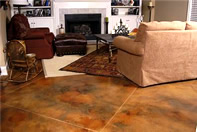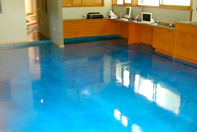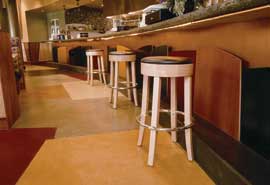Research Stained ConcreteCost, maintenance and more
-
Common Questions
- How do stains work
- Comparing stained concrete to other flooring material
- Is a stained concrete floor right for me?
- Removing an existing covering
- Stained concrete cost
- Staining exterior concrete Design Options
- Color charts
- Tips for choosing the right stain color
- Creating special effects
- Using stencils to create custom designs
- Using concrete overlays
- Cool concrete stain projects Benefits of Stained Concrete
- Customizable look
- Durability
- Eco-friendly
- Reduces allergens Maintenance
- How to protect stained concrete
- Cleaning stained concrete
The Types of Concrete Stains and How They Work
When you go shopping for concrete stain, you'll find two types of products. Each one colors concrete differently and offers a different look.

Example of an acid-stained floor
Reactive stains
A traditional acid-based concrete stain reacts chemically with the concrete surface to produce variegated, translucent color tones and attractive marbling effects. A true acid-based concrete stain contains metallic salts that react with the concrete's lime content. Once the chemical reaction takes place, the stain forms a permanent bond with the concrete and won't chip off or peel away.

Water-based stain in ocean blue
Nonreactive stains
A newer category of concrete stains are water-based acrylics. These products don't rely on a chemical reaction to impart color. Instead, they work more like a paint by depositing their pigment particles in the pores of the concrete. These stains come in a much broader palette of colors than acid stains, and they are easier to apply. But their color effects tend to be more opaque and more uniform.
To learn more, read What Is a True Concrete Stain? at ConcreteNetwork.com.





